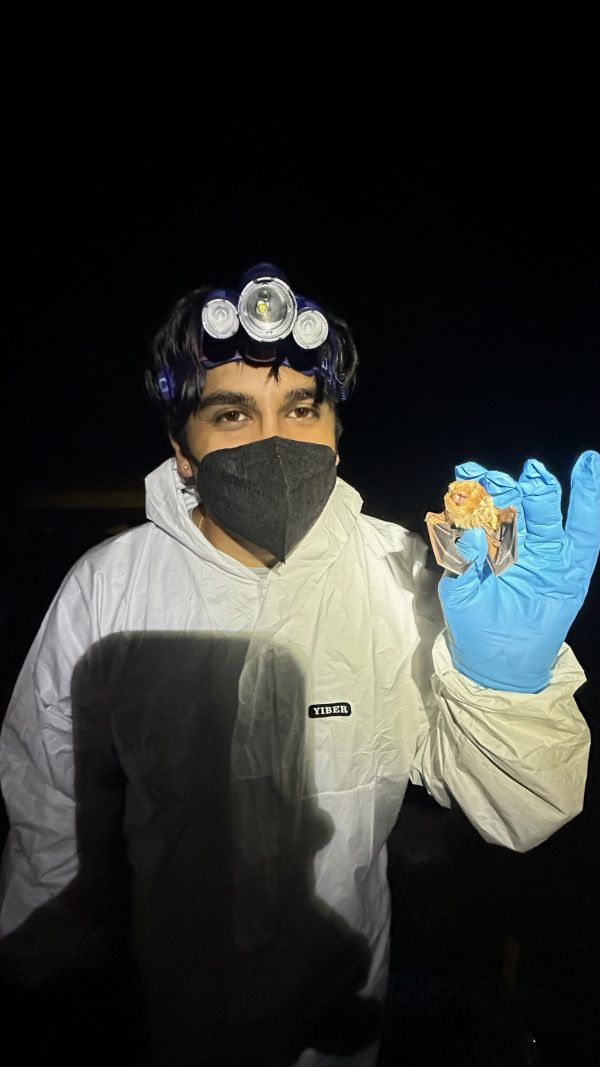Bioinformatics Graduate Rishi Misra’s Race to Save the Bats

Rishi Misra’s excitement is contagious. When he gets going about one of his passions, be it advanced computational biology techniques or the importance of scientific communication, his eyes light up as his enthusiasm spreads to his audience through each animated anecdote and every bit of eager exposition.
“I believe in the fundamental truths of science,” Misra said. “When we test something over and over again, when we have enough data, we can make something new a reality.”
“I want to use science to help people,” he said.
Graduating in December 2025 with a M.S. in bioinformatics, this Arizona-born scholar has devoted his master’s studies here in UNC Charlotte’s College of Computing and Informatics to one organism in particular: the humble bat. The noses of bats, to be specific.
Working in Assistant Professor of Bioinformatics and Genomics Laurel Yohe’s research laboratory, Misra has spent countless hours examining the nasal cavities of these airborne mammals on the hunt for clues about how differences in nose development could help fight a deadly bat disease with important consequences for global food supply and public health.
Along the way, he’s taken part in cutting-edge research all while honing his skills as one of UNC Charlotte’s most skilled scientific speakers, as evidenced by his place on the finalist shortlist of the 2025 annual Three Minute Thesis competition.
Back to Niner Nation
After moving to Charlotte from Arizona near the end of his high school career, Misra first joined UNC Charlotte as an undergraduate in 2019. He eventually transferred to North Carolina State University to pursue a bachelor’s degree in biology with a concentration in neurobiology along with a minor in biotechnology. Investigating different paths he could take post-graduation, UNC Charlotte’s world-class bioinformatics program looked like a perfect fit given his interest in innovative biological research, especially considering the fond memories he had of his previous time at the university.
“There was something that just called me back,” Misra said. “As I looked back, I realized that all of my best times in college were at UNC Charlotte, and that some of my longest-term friendships were still with people that I met here freshman year.”
“I decided to give it a shot — it’s been one of the best decisions I’ve made,” he said.
Bat-Man
Much of Misra’s time back in Niner Nation has been spent in the Yohe lab, where he’s become an affable advocate for the surprising importance of bat research.
Not only do bats make up a staggering 25% of all mammals on Earth, but they also play a pivotal role in the global ecosystems and food chains, Misra explained. Many bats primarily eat insects that would run rampant attacking plants and crops or spreading disease if left unchecked (“nature’s pesticide,” Misra said), while other fruit-eating bats are important pollinators that keep fruit plentiful.

In recent years, a deadly plague known as White-Nose Syndrome has spread from Europe to bat populations in the United States. Afflicted bats are consumed by a deadly fungus that lives in bats’ noses. White-Nose Syndrome can decimate up to 90% of a given bat colony if introduced. The domino effects into local ecosystems, including those in the Eastern United States in and around North Carolina, are staggering.
As part of in-the-field research made possible by UNC Charlotte, Misra has seen firsthand the dramatic effects of White-Nose Syndrome with his own eyes at Rattler Ford Campground in Robinsville, North Carolina. “There’s a direct impact on how many bugs are outside. Fruit-eating bats are not pollinating… it’s really shifting the ecosystem,” he said.
To help fight White-Nose Syndrome, Misra and colleagues have been hard at work studying computerized tomography scans of embryonic bats, a very manual and lengthy process. Along with his research partner and fellow graduate student Ian Jones, Misra makes 3-D models of the nasal cavities of these unborn bats of the fruit-, insect- and blood-eating varieties. They then use advanced artificial intelligence-powered computational techniques to determine the differing ways the nasal cavities of these various bat species evolve over time to better understand how White-Nose Syndrome affects different bats and how it could one day be stopped.
Three-Minute Drill
Besides bats, the other love Misra has found during his graduate studies is science communication, specifically thanks to the annual Three Minute Thesis competition — 3MT for short — hosted by UNC Charlotte and universities around the world.
First started at the University of Queensland in Australia, 3MT invites enterprising graduate students to enthusiastically convey their academic research projects to a general audience with only a single presentation slide and a mere three minutes of speech time.
Participating in 3MT is a time-honored tradition for bioinformatics students at UNC Charlotte, many of whom are encouraged to participate by professor of bioinformatics Anthony Fodor in the graduate program’s required internship class. Misra took Fodor’s pitch on the value of 3MT to heart and decided to enter the competition.
“This was my first time really presenting my work, so I wanted to really put in the effort to show that I have what it takes to communicate science,” Misra said. He devoted himself to perfecting his presentation. Under the mentorship of 3MT advocate Daryl Kerr — faculty associate for graduate teaching in the Reynolds Center for Graduate Life and Learning and former professor and associate dean in the Belk College of Business — Misra honed his pitch, cutting out complex jargon and niche lingo in favor of broadly understandable language.
After “countless rewrites” and plenty of coaching, Misra grew more and more confident with his presentation on the importance of bats (and their noses) on the global ecosystem. Competing against dozens of fellow Niner graduate students, Misra was thrilled to be named one of the top 11 finalists in the 2025 competition, earning him a coveted spot in the final presentation round held on Nov. 19.
While Misra didn’t leave with the top prize — that honor went to his bioinformatics colleague and Ph.D. student Caroline West — Misra said the experience was more than worth it in the end.
“It’s been incredibly validating, and I’m incredibly blessed to have been chosen as one of the finalists in this year’s competition,” Misra said. “Through this process, I’ve learned the importance of being patient and understanding with the audience while giving them a bigger picture to root for in effectively communicating.”
Taking Flight
With his master’s degree nearly in hand, Misra is eager to continue his development in the world of biometrics in any number of directions. His goal is to find a job in industry to gain a fuller picture of how the professional world differs from that of academia, and he’s excited to put his newfound communication skills forged in 3MT to use on the job interview circuit.
“I feel so much more confident now, not just explaining my research, but explaining science in general,” Misra said. “I’m proud of the diverse skill set I’ve gained through my time at UNC Charlotte, and I’m eager to find my niche.”
No matter what path his career takes him, Misra has one overarching aim in mind.
“I went into science to make the world a better place,” he said.